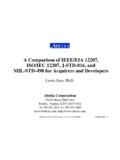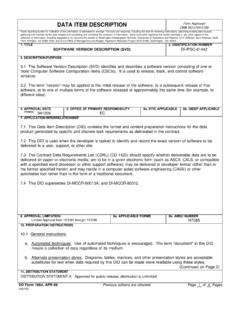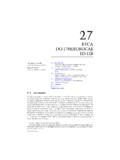Transcription of Overview of MIL-STD-498 and its DIDs - Abelia
1 Overview ofMIL-STD-498and itsData Item Descriptions (DIDs)04/24/95 Topics to be Discussed-What is MIL-STD-498 ?-Significant new terms and definitions- MIL-STD-498 s general requirements (Section 4)- MIL-STD-498 s detailed requirements (Section 5)- Overview of the Data Item Descriptions (DIDs)-Planned aids for applying MIL-STD-4981 What is MIL-STD-498 ?A new DoD software development standard designed to:-"Harmonize" (merge):-DOD-STD- 2167a , Defense System SoftwareDevelopment-DOD-STD-7935A, DoD Automated InformationSystem Documentation-Resolve issues identified in applying DOD-STD- 2167a and its DIDs-Ensure compatibility with recent changes in DOD directives,instructions, standards, and handbooks2 Harmonizing DOD-STD- 2167a with DOD-STD-7935-DOD-STD- 2167a :-Designed for mission critical/weapon system software-Specifies a set of software development activities-Offers 16 DIDs that define documentation-DOD-STD-7935A-Designed for automated information systems-Defines the format and content of 11 documents-Provides guidance for applying the documents-Objective: Combine the best of both to create a single standard for DoD3 Key Issues Identified in Applying 2167A1.
2 Remove perceived preference for "waterfall" development model2. Improve compatibility with Ada/object-oriented methods3. Remove emphasis on preparing documents4. Accommodate use of CASE tools5. Improve links to systems engineering6. Support use of management indicators7. Provide pre-tailoring by categories of software8. Improvecoverageofmodification,reuse,andr eengineering9. Put more emphasis on software supportability10. Improve evaluation and review criteria4 Key Issues Identified in Applying 2167a (cont.)11. Improve distinction between requirements and design12. Improve coverage of database development13. Improve the criteria used for software product evaluations14. Eliminate confusion between software quality assurance and software productevaluation15. Improve use in data intensive systems16. Clarify applicability to more types of projects17. Extend configuration management concepts to in-process work products18. Eliminate inconsistencies and holes in the DIDs19.
3 Decrease dependence on formal reviews and audits20. Improve compatibility with incremental/evolutionary development methods5 Compatibility with DODD, DODI, Standards, Handbooks-Several DODD, DODI, standards, handbooks, etc. were issued, changed, or intransition since DOD-STD- 2167a and 7935A, ,:-DODD and DODD , Defense Acquisition Management-DODD and DODI , AIS Life Cycle Management-MIL-STD-499B, Systems Engineering-MIL-STD-973, Configuration Management-MIL-HDBK-347, MCCR Software Support-Challenge: Ensure compatibility with the new policy, requirements, and guidance6 The MIL-STD-498 PackageCompleted:- MIL-STD-498 : Software Development and Documentation-22 Data Item Descriptions (DIDs)-A "Quick" guidebook explaining key concepts and tailoring of the standardPlanned:-MIL-Guidebook 498 providing more detailed guidance-Other aids7 Format of MIL-STD-498 (and all MIL-STDs) Requirements-Appendixes8 Significant New Terms and Definitions (1)Acquireranddeveloperas the parties involved in the standard(Replaces "contracting agency" and "contractor.)
4 " Supports non-contract SWdevelopment, such as Government in-house development)Build: a version of software that meets a specified subset of a requirements that thecompleted software will meet.(Supports incremental and evolutionary development -- MIL-STD-498 is orientedto developing software in a series of builds)Document:A data medium and the data recorded on it, that generally haspermanence and that can be read by humans or machines.(Supports alternatives to traditional documents, , data in CASE tools. MIL-STD-498 is about natural work products, not documentation)Software: Computer programs and computer databases.(Supports application of MIL-STD-498 to database systems)9 Significant New Terms and Definitions (2)Software product: Software or associated information created, modified, orincorporated to satisfy a contract.(Provides a generic term for talking about the natural work products generatedduring SW development; need not be traditional documents)Software system: A system consisting solely of software and possibly the computerequipment on which the software runs.
5 (Supports application of MIL-STD-498 to software-only systems (such as payrollsystems) as well as to software-hardware systems)Software unit: A logical element of the design of a CSCI; for example, majorsubdivision of a CSCI, a component of that subdivision, a class, object, module,function, routine, or database.(Replaces both CSU and greater flexibility in expressingsoftware design. More compatible with object-oriented design)10 MIL-STD-498 GeneralRequirements11 Software Development Process-Establish a SW development process consistent with contract requirements-Include the following activities:Project planning and oversightEstablish SW devel environmentSystem requirements analysisSystem designSW requirements analysisSW designSW implementation and unit testingUnit integration and testingCSCI testingCSCI/HWCI integration and testingSystem testingPreparing for software usePreparing for software transitionSoftware configuration managementSoftware product evaluationsSoftware quality assuranceCorrective actionJt technical and management reviewsOther (miscellaneous) activitiesRisk managementSoftware management indicatorsSecurity and PrivacySubcontractor ManagementInterface with IV&V agentsCoordination with assoc.
6 DevelopersImprovement of project processes12 General Req ts for SW Development (1)-Use systematic, documented methods-Develop and apply standards for representing requirements, design, code, andtest information-Evaluate reusable SW products for use in fulfilling contract requirements;incorporate those that meet the criteria in the SW Development Plan-Identify opportunities for developing SW products for reuse; notify the acquirerof those that have cost benefits13 General Req ts for SW Development (2)-Establish and apply strategies for handling critical requirements, such as thosewith safety, security, or privacy implications-Analyze and fulfill the computer hardware resource utilization requirements (suchas memory reserves)-Record rationale for key decisions, for use by the support agency-Provide the acquirer access to developer and subcontractor facilities14 MIL-STD-498 DetailedRequirements15 MIL-STD-498 Activities and the Build FrameworkActivityBuild 1 Build 2 Build 3 Build 4 .. Project planning and Establishing a SW development System requirements System Software requirements Software Software implementation and unit Unit integration and CSCI qualification CSCI/HWCI integration and System qualification Preparing for software Preparing for software Software configuration Software product Software quality Corrective Joint technical and management Other activitiesxxxx-19 activities; each may be performed in one or more builds on a project-Activities may be concurrent, sequential, iterative.
7 , as appropriate16 Example Showing One BuildProject planning and oversightSDP STP SIP/STrPCSCIUnit QualCSCI 1: Software Integ/ TestPrepareSoftware Implemen/ Testfor SWSoftware Design Unit Test STR UseReq STDA nalysisExecutable SWSDD/IDD/DBDDSVDsSRS/IRSS ystem User/op manualCSCI CSCI/HWCI QualUnit Qual Integ/ TestCSCI 2: Software Integ/ Test TestSystem Software Implemen/ Test STD STR PrepareSystem Design Software Design Unit Test STR for SWReq Req STD TransitionAnalysis AnalysisSSDD/IDD SDD/IDD/DBDDE xecutable SWOCD SSS/IRS SRS/IRSS ource filesSVDsSPSsUpdated SSDDsHWCI(s) (Not covered by MIL-STD-498 )
8 Support manualsSW devel environment, SW configuration management, SW product evaluation, SW quality assurance, corrective action, joint reviews, risk management,software management indicators, security/privacy, interface with IV&V, coordination with associate developers, improvement of project processesNote: All activities may be more ongoing, overlapping, and iterative than the figure is able to Showing Incremental Development in 2 BuildsBUILD 1: Establish system and software requirements and install software implementing a subset of those requirements at user sitesProject planning and oversightSDP (focus on Build 1) STP for Build 1 SIP for Build 1; Preliminary STrPCSCIP repareUnit Qualfor SWCSCI 1: Software Integ/ TestUseSoftware Implemen/ TestSoftware Design Unit Test STR for Build 1 Executable SWReq STD for Build 1 SVDsAnalysisSystem User/op manuals forPartial SDD/IDD/DBDD CSCI CSCI/HWCI Qual Build 1 SRS/IRS* Unit Qual Integ/ TestSoftware Integ/ Test TestSystem CSCI 2.
9 Software Implemen/ Test STD STR (NoSystem Design Software Design Unit Test STR for for Build 1 SoftwareReq Req STD for Build 1 Transition)Analysis Analysis Build 1 SSDD/IDD* Partial SDD/IDD/DBDDOCD* SSS/IRS* SRS/IRS* (All activities may be moreongoing, overlapping, and iterative*Intended to be HWCI(s) (Not covered by MIL-STD-498 ) than the figure is able to show)complete and stableSW devel environment, SW configuration management, SW product evaluation, SW quality assurance, corrective action, joint reviews, other activitiesBUILD 2: Install the completed software at user sites and transition the software to the software support agencyProject planning and oversightSDP updated STP updated for Build 2 SIP for Build 2.
10 Completed STrPfor Build 2 CSCIP repareUnit Qualfor SWCSCI 1: Software Integ/ TestUseSoftware Implemen/ TestSoftware Design Unit Test STR for Build 2 Executable SWReq STD for Build 2 SVDsAnalysisSystem User/op manuals forComplete SDD/IDD/DBDD CSCI CSCI/HWCI Qual Build 2 SRS/IRS* Unit Qual Integ/ TestSoftware Integ/ Test TestSystem CSCI 2: Software Implemen/ Test STD STR PrepareSystem Design Software Design Unit Test STR for for Build 2 for SWReq Req STD for Build 2 TransitionAnalysis Analysis Build 2 SSDD/IDD* Complete SDD/IDD/DBDDE xecutable SWOCD* SSS/IRS* SRS/IRS*Source files*Updated only ifSPSs, updated SSDD snecessary.





